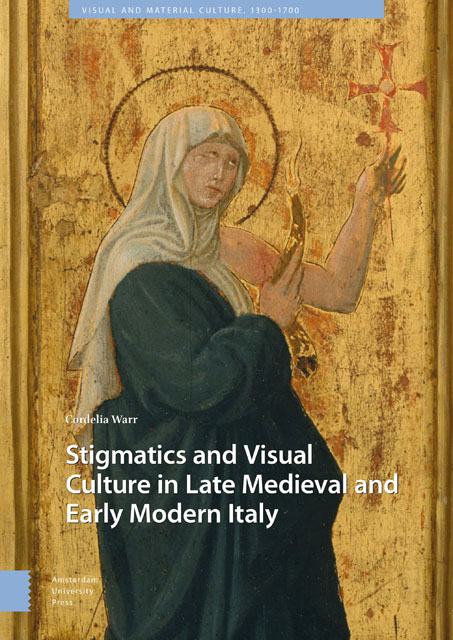Book contents
- Frontmatter
- Table of Contents
- Acknowledgements
- List of Illustrations
- 1 Introduction: Stigmata and Visual Culture
- 2 Saint Francis of Assisi as Image
- 3 Representing the Invisible: Saint Catherine of Siena’s Stigmatization
- 4 The Stigmatic Spectrum and the Visual Arts
- 5 Gregorio Lombardelli, Invisibility, and the Representation of Saint Catherine of Siena’s Stigmata
- 6 Performing Stigmata
- 7 Painting, Printing, Sculpting, Forgery (and Washing)
- 8 Conclusion: The Timidity of the Visual Arts
- Complete Bibliography
- Index
1 - Introduction: Stigmata and Visual Culture
Published online by Cambridge University Press: 06 December 2022
- Frontmatter
- Table of Contents
- Acknowledgements
- List of Illustrations
- 1 Introduction: Stigmata and Visual Culture
- 2 Saint Francis of Assisi as Image
- 3 Representing the Invisible: Saint Catherine of Siena’s Stigmatization
- 4 The Stigmatic Spectrum and the Visual Arts
- 5 Gregorio Lombardelli, Invisibility, and the Representation of Saint Catherine of Siena’s Stigmata
- 6 Performing Stigmata
- 7 Painting, Printing, Sculpting, Forgery (and Washing)
- 8 Conclusion: The Timidity of the Visual Arts
- Complete Bibliography
- Index
Summary
Abstract
By expanding the discussion of stigmata to focus on visual culture, it is possible to deepen our understanding of contemporary visuality as well as our awareness of debates concerning images and image making between the thirteenth and sixteenth centuries. Francis of Assisi (d. 1226) and Catherine of Siena (d. 1380) are important to this debate as the two saints most frequently depicted with miraculous stigmata. However, limiting considerations to representations of these two saints prevents a full understanding of the role of gender in the visual culture of stigmata. By placing Saints Francis and Catherine within the wider context of stigmatic visuality, it is possible to broaden our understanding of issues relating to gender, miracles, and the representation of knowledge.
Keywords: stigmata, visual culture, female stigmatics, Francis of Assisi, Catherine of Siena, miracles
Within the context of the late medieval and early modern Catholic Church, stigmata are often understood as miraculous bodily marks echoing the wounds received by Christ on the cross. The most famous were those received by Francis of Assisi (d. 1226) after a vision when he was staying at a hermitage on Mount La Verna, north of Arezzo, in 1224. In the life of Saint Francis, accepted as the official version at the general chapter of the Franciscan Order held in Pisa in 1263, Saint Bonaventure (d. 1274) described their appearance: nail-like protuberances in the centre of the hands and feet, and a bleeding side wound. The wounds were miraculous, their placement on Francis's body was clearly significant, and the Franciscans promoted them as unique.
However, the marks on Francis's body did not appear ex nihilo and the history of stigmata is a long one. Body markings referred to as stigmata had been known since Antiquity. It was only in the century following the death of Saint Francis that the definition of stigmata as miraculous marks, mirroring those received by Christ on the cross, gained ground. It was not uncontested and a wider definition of stigmata was actively promoted in some quarters, particularly by the Dominicans.
Francis's stigmata appeared within a culture of affective piety, one that the order he founded did much to propagate, but which was already embedded in the religious practices of the previous century.
- Type
- Chapter
- Information
- Publisher: Amsterdam University PressPrint publication year: 2022



